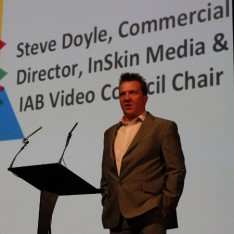‘Clients must move beyond click-through rate as a metric in online ads’ says Inskin Media boss

Doyle: “We want to deliver a metric that will analyse the quality of campaigns”
The commercial boss of ad tech firm Inskin Media says marketers need to move beyond click-through rates as a measure of effectiveness in online advertising.
Steve Doyle, who was in Australia last week to promote Inskin Media’s new partnership with analytics firm, Moat, also argued the Australian industry as a whole needs work together on agreed standards of viewability.
“This is something we have pushing, we have wanted advertisers to move beyond click-through rates as a way of measuring brand advertising,” Doyle told Mumbrella.
“Click-through is a useful indicator but at the end of the day if you are just looking at the number of clicks you are not looking at the depth of engagement or quality of the interaction.
“It’s a proxy for direct response mentality advertising, looking to have some sort of metric on a brand campaign. We want to move the dial and allow advertisers to better understand how to measure brand advertising online.”
Inskin Media is an advertising technology business that specialises in high-impact, non-intrusive brand advertising formats on websites, and Doyle says the new partnership is aimed at giving marketers new metrics to assess brand campaigns.
“We have been looking at viewability for up to three years,” said Doyle. “The nature of our non-standard ads means we have very high scores in the area of viewability so as a business opportunity it’s a big thing.
“We have been saying our ads have been highly in-view for some time but without any real science behind it.”
According to Doyle, too many advertisers are taking a direct response mentality to online display advertising when in fact he argues they need to have metrics around it as a brand-building campaign.
“This is about giving advertisers more information about the brand advertising they are purchasing and how they determine if a campaign has been success,” he said.
“What we wanted was to deliver a viewability metric that would allow them to analyse the quality of their campaigns more effectively; and I’m talking specifically about brand metrics as opposed to direct response metrics.”
The topic of viewability has made headlines in recent months in Australia with both holding groups IPG Mediabrands and GroupM striking out and pushing their own metrics on the topic.
Doyle was reluctant to be drawn on the local politics around viewability, but argued that Moat, a relatively new player in this market – entering on the back of its new GroupM viewability deal – had a strong track record in other markets.
“The conversation in the UK has started to mature a little bit,” he said. “It is still in its infancy but where there are agreed standards and they are moving more aggressively (to industry agreement).
“The coordination of viewability standards in the US and UK has been led by the IAB. I don’t think the issues are more agreed on,” Doyle argued, claiming the UK, US and Australia are all in the mid-40s in terms of the percentage seen across all displays.
“The IAB in the UK is 25 staff; they have the resources to lead the debate. I don’t think the publishers are any more or less engaged, in the UK there is just a central level of coordination.
“The key thing is that they are ‘step one’.”
Nic Christensen


That headline’s made me all misty-eyed for the early 2000s when it first started appearing.
The article is okay though I am not sure of the purpose. It’s the same topic for many years now and it is a valid one, but there is nothing “new” in this news. It feels like it was written for the sake of writing it and it did not have the “eureka” moment I thought it would have. Just my feedback for future articles. Thank you.